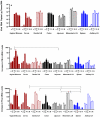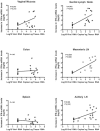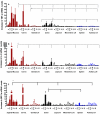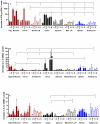Temporal and anatomic relationship between virus replication and cytokine gene expression after vaginal simian immunodeficiency virus infection
- PMID: 16160143
- PMCID: PMC1211549
- DOI: 10.1128/JVI.79.19.12164-12172.2005
Temporal and anatomic relationship between virus replication and cytokine gene expression after vaginal simian immunodeficiency virus infection
Abstract
The current knowledge about early innate immune responses at mucosal sites of human immunodeficiency virus (HIV) entry is limited but likely to be important in the design of effective HIV vaccines against heterosexual transmission. This study examined the temporal and anatomic relationship between virus replication, lymphocyte depletion, and cytokine gene expression levels in mucosal and lymphoid tissues in a vaginal-transmission model of HIV in rhesus macaques. The results of the study show that the kinetics of cytokine gene expression levels in the acute phase of infection are positively correlated with virus replication in a tissue. Thus, cytokine responses after vaginal simian immunodeficiency virus (SIV) inoculation are earliest and strongest in mucosal tissues of the genital tract and lowest in systemic lymphoid tissues. Importantly, the early cytokine response was dominated by the induction of proinflammatory cytokines, while the induction of cytokines with antiviral activity, alpha/beta interferon, occurred too late to prevent virus replication and dissemination. Thus, the early cytokine response favors immune activation, resulting in the recruitment of potential target cells for SIV. Further, unique cytokine gene expression patterns were observed in distinct anatomic locations with a rapid and persistent inflammatory response in the gut that is consistent with the gut being the major site of early CD4 T-cell depletion in SIV infection.
Figures




References
-
- Abel, K., L. Compton, T. Rourke, D. Montefiori, D. Lu, K. Rothaeusler, L. Fritts, K. Bost, and C. J. Miller. 2003. Simian-human immunodeficiency virus SHIV89.6-induced protection against intravaginal challenge with pathogenic SIVmac239 is independent of the route of immunization and is associated with a combination of cytotoxic T-lymphocyte and alpha interferon responses. J. Virol. 77:3099-3118. - PMC - PubMed
-
- Abel, K., L. La Franco-Scheuch, T. Rourke, Z. M. Ma, V. De Silva, B. Fallert, L. Beckett, T. A. Reinhart, and C. J. Miller. 2004. Gamma interferon-mediated inflammation is associated with lack of protection from intravaginal simian immunodeficiency virus SIVmac239 challenge in simian-Human immunodeficiency virus 89.6-immunized rhesus macaques. J. Virol. 78:841-854. - PMC - PubMed
-
- Ada, G. L., and P. D. Jones. 1986. The immune response to influenza infection. Curr. Top. Microbiol. Immunol. 128:1-54. - PubMed
-
- Andreakos, E., B. Foxwell, and M. Feldmann. 2004. Is targeting Toll-like receptors and their signaling pathway a useful therapeutic approach to modulating cytokine-driven inflammation? Immunol. Rev. 202:250-265. - PubMed
-
- Belardelli, F., and I. Gresser. 1996. The neglected role of type I interferon in the T-cell response: implications for its clinical use. Immunol. Today 17:369-372. - PubMed
Publication types
MeSH terms
Substances
Grants and funding
- R24 RR014555/RR/NCRR NIH HHS/United States
- U19 AI055793/AI/NIAID NIH HHS/United States
- P01 AI055793/AI/NIAID NIH HHS/United States
- P51 RR000169/RR/NCRR NIH HHS/United States
- U51RR00169/RR/NCRR NIH HHS/United States
- U01 AI057264/AI/NIAID NIH HHS/United States
- AI055793/AI/NIAID NIH HHS/United States
- DE016541-01/DE/NIDCR NIH HHS/United States
- AI57264/AI/NIAID NIH HHS/United States
- AI44480/AI/NIAID NIH HHS/United States
- RR0169/RR/NCRR NIH HHS/United States
- RR14555/RR/NCRR NIH HHS/United States
- R21 DE016541/DE/NIDCR NIH HHS/United States
LinkOut - more resources
Full Text Sources
Research Materials

